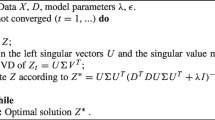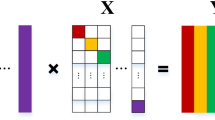Abstract
Learning dictionaries from the training data has led to promising results for pattern classification tasks. Dimensionality reduction is also an important issue for pattern classification. However, most existing methods perform dimensionality reduction (DR) and dictionary learning (DL) independently, which may result in not fully exploiting the discriminative information of the training data. In this paper, we propose a simultaneous dimensionality reduction and dictionary learning (SDRDL) model to learn a DR projection matrix and a class-specific dictionary (i.e., the dictionary atoms correspond to the class labels) simultaneously. Since simultaneously learning makes the learned projection and dictionary fit better with each other, more effective pattern classification can be achieved using the representation residual. In SDRDL model, not only the representation residual is discriminative, but the representation coefficients are also discriminative. Therefore, a classification scheme associated with SDRDL is presented by exploiting such discriminative information. Experimental results on a series of benchmark image databases show that our proposed method outperforms many state-of-the-art discriminative dictionary learning methods.






Similar content being viewed by others
References
Aharon M, Elad M, Bruckstein A (2006) K-SVD: an algorithm for designing overcomplete dictionaries for sparse representation. IEEE Trans Signal Process 54(1):4311–4322
Beck A, Teboulle M (2009) A fast iterative shrinkage-thresholding algorithm for linear inverse problems. SIAM J Imag Sci 2(1):183–202
Belhumeur PN, Hespanha JP, Kriegman DJ (1997) Eigenfaces vs. fisherfaces: recognition using class specific linear projection. Pattern Anal Mach Intell IEEE Trans 19(7):711–720
Bengio S, Pereira F, Singer Y, Strelow D (2009) Group sparse coding. In: Proceedings of the Neural Information Processing Systems
Boyd S, Vandenberghe L (2004) Convex optimization. Cambridge University Press, New York
Bryt O, Elad M (2008) Compression of facial images using the k-svd algorithm. J Vis Commun Image Represent 19(4):270–282
Cai S, Zuo W, Zhang L, Feng X, Wang P (2014) Support vector guided dictionary learning. In: Computer Vision–ECCV. pp 624–639
Candès EJ et al (2006) Compressive sampling. In: Proceedings of the international congress of mathematicians, vol. 3. Madrid, Spain, pp 1433–1452
Castrodad A, Sapiro G (2012) Sparse modeling of human actions from motion imagery. Int J Comput Vis 100:1–15
Elad M, Aharon M Image denoising via sparse and redundant representations over learned dictionaries. IEEE Trans Image Process 15(12):3736–3745
Elad M, Aharon M (2006) Image denoising via learned dictionaries and sparse representation. In: Computer Vision and Pattern Recognition, vol. 1. pp 895–900
Feng Z, Yang M, Zhang L, Liu Y, Zhang D (2013) Joint discriminative dimensionality reduction and dictionary learning for face recognition. Pattern Recogn 46(8):2134–2143
Georghiades A, Belhumeur P, Kriegman D (2001) From few to many: illumination cone models for face recognition under variable lighting and pose. IEEE Trans Pattern Anal Mach Intell 23(6):643–660
Guha T, Ward RK (2012) Learning sparse representations for human action recognition. IEEE Trans Pattern Anal Mach Learn 34(8):1576–1888
Hoyer PO (2002) Non-negative sparse coding. In: Proceedings of the IEEE Workshop Neural Networks for Signal Processing
Huang K, Aviyente S (2006) Sparse representation for signal classification. In: Advances in neural information processing system. pp 609–616
Jenatton R, Mairal J, Obozinski G, Bach F (2011) Proximal methods for hierarchical sparse coding. J Mach Learn Res 12:2234–2297
Jiang ZL, Zhang GX, Davis LS (2012) Submodular dictionary learning for sparse coding. In: Proceedings of the IEEE Conference Computer Vision and Pattern Recognition
Jiang ZL, Lin Z, Davis LS (2013) Label consistent K-SVD: learning a discriminative dictionary for recognition. IEEE Trans Pattern Anal Mach Intell 34:533
Kong S, Wang DH (2012) A dictionary learning approach for classification: Separating the particularity and the commonality. In: Proceedings of the European Conference on Computer Vision
Mairal J, Elad M, Sapiro G (2008a) Sparse representation for color image restoration. Image Process IEEE Trans 17(1):53–69
Mairal J, Bach F, Ponce J, Sapiro G, Zissserman A (2008b) Learning discriminative dictionaries for local image analysis. In: Proceedings of the IEEE Conference on Computer Vision and Pattern Recognition
Mairal J, Leordeanu M, Bach F, Hebert M, Ponce J (2008c) Discriminative sparse image models for class-specific edge detection and image interpretation. In: Proceedings of the European Conference on Computer Vision
Mairal J, Bach F, Ponce J, Sapiro G, Zisserman A (2009) Supervised dictionary learning. In: Proceedings of the Neural Information and Processing Systems
Mairal J, Bach F, Ponce J (2012) Task-driven dictionary learning. IEEE Trans Pattern Anal Mach Intell 34(4):791–804
Martinez A, Benavente R (1998) The AR face database, CVC Technical Report 24
Niyogi X (2004) Locality preserving projections. In: Neural information processing systems, vol. 16. MIT, p 153
Olshausen BA, Field DJ (1997) Sparse coding with an overcomplete basis set: a strategy employed by v1? Vis Res 37(23):3311–3325
Olshausen BA et al (1996) Emergence of simple-cell receptive field properties by learning a sparse code for natural images. Nature 381(6583):607–609
Petrou M, Bosdogianni P (1999) Image processing: the fundamentals. Wiley
Pham D, Venkatesh S (2008) Joint learning and dictionary construction for pattern recognition. In: Proceedings of the IEEE Conference Computer Vision and Pattern Recognition
Qiu Q, Jiang ZL, Chellappa R (2011) Sparse dictionary-based representation and recognition of action attributes. In: Proceedings of the International Conference on Computer Vision
Ramirez I, Sprechmann P, Sapiro G (2010) Classification and clustering via dictionary learning with structured incoherence and shared features. In: Computer Vision and Pattern Recognition (CVPR), IEEE Conference on. IEEE, 2010, pp 3501–3508
Rodriguez F, Sapiro G (2007) Sparse representation for image classification: Learning discriminative and reconstructive nonparametric dictionaries. Preprint: IMA, p 2213
Rodriguez M, Ahmed J, Shah M (2008) A spatio-temporal maximum average correlation height filter for action recognition. In: Proceedings of the IEEE Conference on Computer Vision and Pattern Recognition
Sadanand S, Corso JJ (2012) Action bank: a high-level representation of activeity in video. In: Proceedings of the IEEE Conference on Computer Vision and Pattern Recognition
Sprechmann P, Sapiro G (2010) Dictionary learning and sparse coding for unsupervised clustering. In: Proceedings of the International Conference on Acoustics Speech and Signal Processing
Szabo Z, Poczos B, Lorincz A (2011) Online group-structured dictionary learning. In: Proceedings of the IEEE Conference on Computer Vision and Pattern Recognition
Turk M, Pentland AP et al (1991) Face recognition using eigenfaces. In: Computer Vision and Pattern Recognition. pp. 586–591
Wagner A, Wright J, Ganesh A, Zhou Z, Mobahi H, Ma Y (2012) Toward a practical face recognition system: robust alignment and illumination by sparse representation. Pattern Anal Mach Intell IEEE Trans 34(2):372–386
Wang HR, Yuan CF, Hu WM, Sun CY (2012) Supervised class-specific dictionary learning for sparse modeling in action recognition. Pattern Recogn 45(11):3902–3911
Wright J, Yang AY, Ganesh A, Sastry SS, Ma Y (2009a) Robust face recognition via sparse representation. Pattern Anal Mach Intell IEEE Trans 31(2):210–227
Wright JS, Nowak DR, Figueiredo TAM (2009b) Sparse reconstruction by separable approximation. IEEE Trans Signal Process 57(7):2479–2493
Wu YN, Si ZZ, Gong HF, Zhu SC (2010) Learning active basis model for object detection and recognition. Int J Comput Vis 90:198–235
Yang M, Zhang L (2010) Gabor feature based sparse representation for face recognition with gabor occlusion dictionary. In: Computer Vision–ECCV 2010. Springer, pp 448–461
Yang JC, Yu K, Huang T (2010a) Supervised translation-invariant sparse coding. In: Proceedings of the IEEE Conference Computer Vision and Pattern Recognition
Yang M, Zhang L, Yang J, Zhang D (2010b) Metaface learning for sparse representation based face recognition. In: Proceedings of the IEEE Conference on Image Processing
Yang M, Zhang L, Yang J, Zhang D (2011a) Robust sparse coding for face recognition. In: Computer Vision and Pattern Recognition (CVPR). pp 625–632
Yang M, Zhang L, Feng XC, Zhang D (2011b) Fisher discrimination dictionary learning for sparse representatio. In: Proceedings of the International Conference on Computer Vision
Yang M, Zhang L, Feng XC, Zhang D (2014) Sparse representation based fisher discrimination dictionary learning for image classification. Int J Comput Vis 109(3):209–232
Yao A, Gall J, Gool LV (2010) A hough transform-based voting framework for action recognition. In: Proceedings of the IEEE Conference on Computer Vision and Pattern Recognition
Zhang Q, Li B (2010) Discriminative k-svd for dictionary learning in face recognition. In: Computer Vision and Pattern Recognition (CVPR). pp 2691–2698
Zhang L, Yang M, Feng Z, Zhang D (2010) On the dimensionality reduction for sparse representation based face recognition. In: Pattern Recognition (ICPR), 2010 20th International Conference on IEEE. pp 1237–1240
Zhou N, Fan JP (2012) Learning inter-related visual dictionary for object recognition. In: Proceedings of the IEEE Conference on Computer Vision and Pattern Recognition
Zhou MY, Chen HJ, Paisley J, Ren L, Li LB, Xing ZM et al (2012) Nonparametric Bayesian dictionary learning for analysis of noisy and incomplete images. IEEE Trans Image Process 21(1):130–144
Acknowledgments
This work was supported by National Instrument Development Special Program of China under the grants 2013YQ03065101, 2013YQ03065105, Ministry of Science and Technology of China under National Basic Research Project under the grants 2010CB731803, and by National Natural Science Foundation of China under the grants 61221003, 61290322, 61174127, 61273181, 60934003, 61290322, 61503243 and U1405251, the Program of New Century Talents in University of China under the grant NCET-13-0358, the Science and Technology Commission of Shanghai Municipal, China under the grant 13QA1401900, Postdoctoral Science Foundation of China under the grants 2014 M551406.
Author information
Authors and Affiliations
Corresponding authors
Appendix
Appendix
φ i (Z i ) is convex and continuously differentiable with Lipschitz continuous gradient L(φ i ):
where ‖ ⋅ ‖ denotes the standard Euclidean norm and L(φ i ) > 0 is the Lipschitz constant of ∇φ i .
In Eq. (10)
Let Z i i = P i Z i and Z j i = P j Z i where P i(P j) are projection matrixes which keeps components of Z i (Z j ) associated with D i (D j ) unchanged but sets other components to be zero. Hence, we can rewrite Eq. (22) as:
Let DP i = D i and DP j = D j. Equation (23) equals to:
The stacking operator introduced in [30] can be used to write B i and Z i as a column vector. We form \( {\varPsi}_i={\left[{b}_{i,1},{b}_{i,2},\cdots, {b}_{i,{n}_i}\right]}^T \), \( {\chi}_i={\left[{z}_{i,1},{z}_{i,2},\cdots, {z}_{i,{n}_i}\right]}^T \) where a i,i , z i,i ∈ R m × 1 and thus \( {\varPsi}_i,{\chi}_i\in {R}^{\left(m\cdot {n}_i\right)\times 1} \). Hence, Eq. (24) can be rewrite as:
where diag(T) is a block diagonal matrix with each block on the diagonal being matrix T. And also φ i (χ i ) equals to:
The convexity of φ i (χ i ) depends on its Hessian matrix ∇2 φ i (χ i ) is whether positive semi-definite or not [5]. We could write the Hessian matrix of φ i (χ i ) as:
Since diag(D T D), diag(D iT D i), diag(∑ j ≠ i D jT D j) and \( \mathrm{diag}\left({\displaystyle {\sum}_{j\ne i}{\tilde{\chi}}_j{\tilde{\chi}}_j^T}\right) \) are all Hermite matrix, they are all positive semi-definite. Therefore, Hessian matrix ∇2 φ i (χ i ) is positive semi-definite. Based on this, we claim that φ i (χ i ) is a convex function.
Via Eq. (26), we have:
From Eq. (28), we can easy see that ∇φ i (χ i ) is continuously differentiable to χ i . And via Eq. (28), we have:
Hence, we obtain:
where λ 1 max = λ max(diag(D T D)), λ 2 max = λ max(diag(D iT D i)), λ 3 max = λ max(diag(∑ j ≠ i D jT D j)) and \( {\lambda}_{\max}^4={\lambda}_{\max}\left(\mathrm{diag}\left({\displaystyle {\sum}_{j\ne i}{\tilde{\chi}}_j{\tilde{\chi}}_j^T}\right)\right) \). So the (smallest) Lipschitz constant of the gradient ∇φ i (χ i ) is L(φ i ) = 2(λ 1 max + λ 2 max + λ 3 max + λ 2 λ 4 max ).
Therefore, we claim that φ i (Z i ) is continuously differentiable with Lipschitz continuous gradient L(φ i ).
Rights and permissions
About this article
Cite this article
Yang, BQ., Gu, CC., Wu, KJ. et al. Simultaneous dimensionality reduction and dictionary learning for sparse representation based classification. Multimed Tools Appl 76, 8969–8990 (2017). https://doi.org/10.1007/s11042-016-3492-1
Received:
Revised:
Accepted:
Published:
Issue Date:
DOI: https://doi.org/10.1007/s11042-016-3492-1




